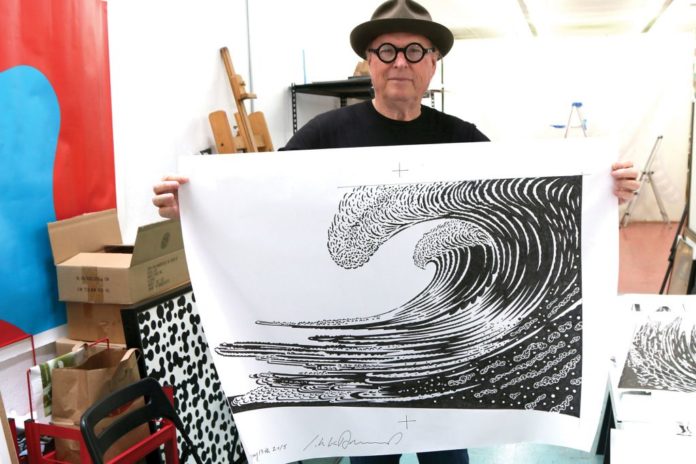FABLED ARTIST JOHN VAN HAMERSVELD’S ICONIC DRAWINGS AND IMAGES —often inspired by cannabis—include the world-famous and groundbreaking poster for Bruce Brown’s landmark surf ln The Endless Summer, along with posters and album artwork for Jimi Hendrix, Jefferson Airplane, Cream, Bob Dylan, the Rolling Stones, and the Beatles. His work has been lighting up bedrooms, art galleries, and dorm rooms with West Coast day-glow Pop Art sensations since 1964. In fact, twenty years ago, artist Shepard Fairey paid Van Hamersveld the ultimate tribute by replacing his Hendrix image with Fairey’s own calling card: a graphic evocation of wrestler Andre the Giant. Fairey called Van Hamersveld’s original poster “a perfect image” and “my favorite poster of all time… an epiphany that sharpened my focus as an artist.” Recently, Van Hamersveld brought his magic touch to a series of prints honoring legendary poet and writer Charles Bukowski and Bob Dylan.
IN YOUR RECENT BOOK, YOU WROTE THAT IN 1967 JEFFERSON AIRPLANE GAVE YOU SOME WEED THAT “HELPED” YOU DESIGN THE FRONT COVER OF THEIR CROWN OF CREATION ALBUM, A FIERY MUSHROOM CLOUD WITH THE BAND INSIDE IT. WHAT’S THE STORY THERE?
Yeah, a half-kilo landed on my drawing table. By putting me under the in uence for June to August, when the album art was nally nished for production, it cost them $9,000 total. I didn’t see the kilo as payment, though. I said, ‘Fuck You!’ ey were pissed-o , but they were groovy when we met again when I was in New York City. By then, Crown of Creation was a hit record.
HOW MUCH DID CANNABIS INFLUENCE YOUR ART AND POSTERS?
A lot. Cannabis makes you see different as an artist in terms of depth and color. It is about learning how to see, really. As Eric Clapton says, “the drugs just get you there faster.”
YOUR ICONIC THE ENDLESS SUMMER MOVIE POSTER WAS ASSOCIATED WITH THE EMERGING THC AND PSYCHEDELIC WORLD—EVEN BEING SOLD IN HEAD SHOPS. AT THE FIFTY-YEAR MARK, WHAT HAS THIS THE ENDLESS SUM- MER IMAGE BECOME?
At the time, I was surprised to see e End- less Summer poster in a dark room with all those other scary posters. When I left Dana Point, California, in 1964, only the beatniks down the street playing jazz took acid and smoked pot. Hipsters and hippies didn’t arrive until late-1965, with Timothy Leary’s “Turn on, tune in, drop out,” and, of course, Bob Dylan. But, yeah, that poster sold everywhere and to anyone worldwide.
TALK ABOUT THE 2005 CREAM POSTER YOU DESIGNED FOR THEIR REUNION GIG IN LONDON.
What stands out about designing the poster for the Cream reunion was that it sold out in London. e poster was a hit, and Rhino distributed it on the cover and DVD everywhere. My mind was just blown by the attention I got when I did seventeen signings at Tower Records; it seemed to reignite a whole new way of looking at the rock art-and-entertainment scene. Back in the day, Disney bought the art school where I was studying and turned it into an art and performance school, which led to me creating the Pinnacle Production concert posters. I feel like the tour, in a way, was an extension of that and a way of introducing the art to new fans.
YOU’VE JUST DONE A SERIES OF BOB DYLAN AND CHARLES BUKOWSKI DRAWINGS AND PRINTS. WHY NOW?
Yes. I moved to San Pedro and opened a store to sell my work. e store is on 6th Street, where I bought my navy bell-bot- toms and hippie clothes in 1965. e whole experience I am having right now is like being back in art school in Los Angeles. San Pedro seems to be set in the past—like when I used to listened to Bob Dylan and read Bukowski. Essentially, the drawings are like symbols of my youth, but the im- ages are bold and charismatic.
YOU DID A SUMMER OF LOVE POSTER TEN YEARS AGO. THE FIFTIETH AN- NIVERSARY OF THE SUMMER OF LOVE IS APPROACHING IN 2017. WHAT ARE YOUR RECOLLECTIONS OF THAT ERA AND HOW YOUR ART FIT IN?
As a fan and concert promoter back then, the music was the backdrop to all media, clothing, record stores, on the FM stations and the albums would tell stories in an abstract way as to what was happening in society. e concert poster promoted the shows, too, and could be taken home and hung on your wall. Sort of like an album cover—you could still smell them, read them, and remember them. I can still hear the Beatle’s Magical Mystery Tour lyrics in my head today: ‘ ere’s a fog upon L.A., and my friends have lost their way. We’ll be over soon.”
To purchase Van Hamersveld’s prints for your shop, visit Post-Future.com.
FOR YOUR WAITING ROOM
JOHN VAN HAMERSVELD— COOLHO– — USE STUDIO: FIFTY YEARS OF GRAPHIC DESIGN
THE EXCITING VISUAL ARC of John Van Hamersveld’s long and storied career is encapsulated in Fifty Years of Graphic Design. The book features Van Hamersveld’s illustrations, graphic designwork, and photographs. Amazing anec- dotes ranging from his dealings with music executives when designing album covers to getting high with Jefferson Airplane accompany the graphic work, bringing the collection to life.
In the early 1960s, while attending Art Center College of Design by day, he began his professional career as art director of Surfer magazine. By the mid-1960s, Van Hamersveld’s groundbreaking promotional poster for the cult surf film The Endless Summer was making the rounds and a name for its creator. Eventually, Van Ham- ersveld directed his talents toward creating stunning concert posters promoting shows by the likes of Jimi Hendrix, Jefferson Airplane, The Who, and others. In the late ’60s, Van Hamersveld was hired as an art director for Capitol Records where he went on to design 300 album covers, including The Magical Mystery Tour by The Beatles, Exile on Main Street by the Rolling Stones, Skeletons from the Closet by the Grateful Dead, Eat to The Beat by Blondie, and This is What You Want by Public Image Ltd., to name a few. Van Hamersveld’s psyche- delic renderings, whether for posters or albums, are widely regarded as some of the best of the form, but what readers may be surprised to learn is just how dynamic the rest of his work is. His output as a draftsman, designer, and photographer continues to astound. —Amazon.com












